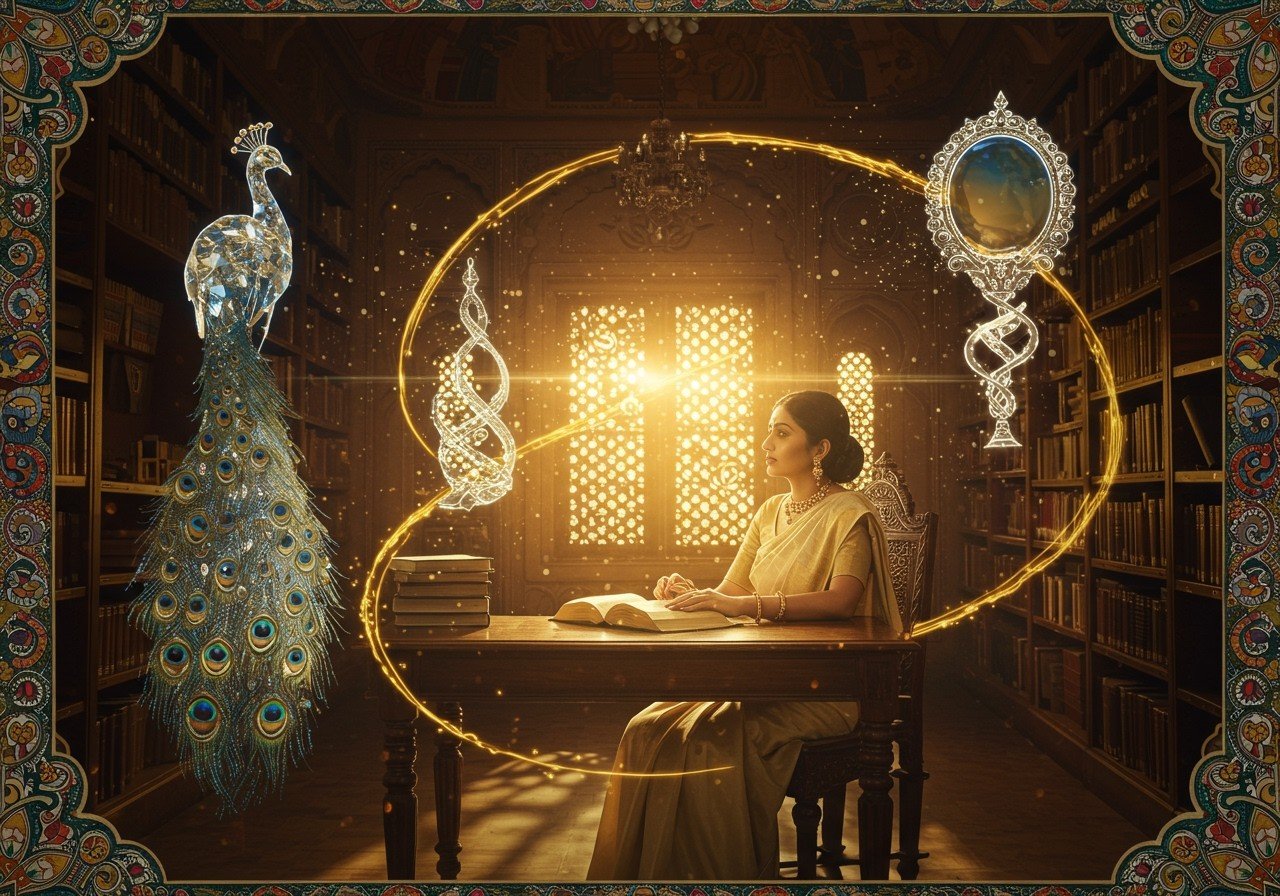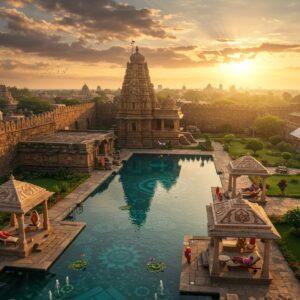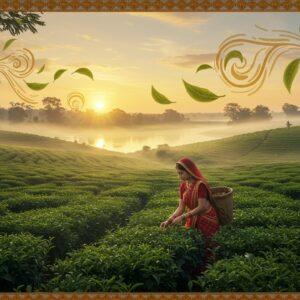
Delving into the world of Alankaras, or figures of speech, unveils a captivating realm within classical Indian literature and arts. These literary devices, much like intricate carvings on a temple, adorn our written and spoken word, adding layers of beauty, depth, and resonance. They reflect India’s rich cultural tapestry, connecting us to the aesthetic sensibilities of our ancestors. By exploring Alankaras, we not only enhance our understanding of traditional storytelling but also deepen our appreciation for the nuances of language itself.
Decoding the Essence of Alankaras
Alankaras, in essence, are figures of speech that embellish literary compositions. They act as powerful tools, amplifying emotional and aesthetic expressions in both poetry and prose. Think of them as the spices that transform ordinary ingredients into a culinary masterpiece. These figures of speech are broadly classified into two main categories:
- Shabdalankaras: These are sound-based embellishments, focusing on the musicality of language. They create rhythm and flow, making the words themselves a source of aesthetic pleasure. Imagine the gentle lull of waves or the rhythmic beat of a drum – Shabdalankaras evoke a similar sonic appeal. They play with the sounds of words to create a symphony for the ears.
- Arthaalankaras: These embellishments work on the level of meaning. They enrich the imagery, evoke deeper emotions, and add layers of interpretation. Like a skilled painter adding depth and detail to a canvas, Arthaalankaras paint vivid pictures with words, allowing us to experience the text on a visceral level. They engage our imagination and make the writing come alive.
By transforming everyday language into artistic expression, Alankaras infuse rhythm, emotion, and vibrant imagery into literary works, crafting a more engaging and aesthetically pleasing experience for the reader or listener.
Alankaras in Sanskrit: A Timeless Tradition
In the venerable tradition of Sanskrit literature, Alankaras hold a position of paramount importance. Their roots can be traced back to seminal texts like the Natyashastra (a treatise on performing arts) and the Kavyashastra (a treatise on poetry), which laid the groundwork for their usage in enhancing both beauty and emotional depth in literary creations. These ancient texts recognized the power of Alankaras to elevate language and touch the human soul.
Literary giants like Kalidasa and Bharavi wielded Alankaras with mastery, demonstrating their ability to imbue poetry with profound meaning and captivating imagery. Imagine the vibrant depictions and emotional resonance in Kalidasa’s verses, all brought to life through the skillful application of these literary ornaments. Their works serve as a testament to the timeless power of these figures of speech.
The study of Sanskrit often entails a deep dive into Alankaras, as they form an integral part of understanding its rich literary traditions. Students explore how ancient writers employed these tools to convey complex emotions and paint vivid scenes, bridging the gap between language and experience. It’s like learning the secret language of the poets.
For a deeper understanding of the Ramayana, its influence on Indian art and literature, and the geographical context of Ayodhya and Lanka, you can explore these insightful resources:
- Ramcharitmanas: A Deep Dive into Devotion and Epic Narrative
- Ayodhya and Lanka: Ramayana Geography Explained
- Ramayana’s Impact: Indian Art and Literature
Alankara Shastra: The Science of Literary Ornaments
Alankara Shastra is the dedicated study of these figures of speech, serving as a guiding light for poets and writers in their pursuit of impactful literature. Luminaries like Bhamaha, Dandin, and Rudrata have made invaluable contributions to this field, developing frameworks for classifying and understanding the diverse tapestry of Alankaras. Their work provides a roadmap for navigating the intricate world of literary embellishments.
This study involves a meticulous exploration of the various characteristics and functions of Alankaras, equipping writers with the knowledge to wield them effectively. By understanding the nuances of these figures of speech, writers can create works that resonate deeply with audiences, captivating them with their beauty and emotional power. It’s like having a toolbox filled with exquisite instruments for crafting compelling narratives.
The influence of Alankara Shastra continues to reverberate in the present day, offering valuable insights into the creation of aesthetically pleasing literature. It bridges the gap between classical techniques and modern creativity, allowing writers to draw inspiration from the rich heritage of the past while forging new paths of expression.
Illustrating Common Alankaras
A grasp of common Alankaras can significantly enrich our appreciation of literature. Let’s illuminate a few examples:
- Upama (Simile): This figure of speech draws a comparison between two distinct entities using words like “as” or “like.” The phrase “She shines like the moon” evokes a vivid image of radiant beauty, transferring the moon’s luminescence to the subject. Similes create a direct and relatable connection between two seemingly disparate things.
- Rupaka (Metaphor): Unlike a simile, a metaphor makes a direct comparison without using “like” or “as.” The statement “Time is a thief” paints a powerful image of time stealthily stealing moments away. Metaphors add a layer of depth and symbolism, inviting us to interpret the comparison in a more nuanced way. They create a sense of immediacy and impact.
- Anuprasa (Alliteration): This involves the repetition of consonant sounds at the beginning of words in close proximity. The phrase “sweet songs soothe souls” creates a melodic effect, drawing attention to the interplay of sound and meaning. Alliteration adds a musicality to the language, enhancing its aesthetic appeal and making it more memorable.
These examples showcase how Alankaras infuse literary works with charm and depth. Their presence can be felt in both classical texts and modern literature, demonstrating their ability to bridge cultural expressions across time. These timeless tools continue to resonate with readers and writers, reminding us of the enduring power of language to evoke emotion and paint vivid pictures in our minds.
The Cultural Significance of Alankaras
Within Indian literary traditions, Alankaras carry profound cultural and thematic significance. They serve as more than just decorative elements; they are integral to the art of storytelling, conveying emotions and imagery with remarkable effectiveness. They act as a cultural lens, shaping our understanding of the world and our place within it. They connect us to our shared heritage and provide a framework for interpreting the human experience.
Alankaras in the Modern Age
The influence of Alankaras extends far beyond the realm of classical literature, permeating modern writing in both regional languages and English. Contemporary writers often employ these figures of speech to establish a link with their cultural roots while exploring contemporary themes. This blending of tradition and innovation creates a rich tapestry of literary expression.
The incorporation of Alankaras plays a vital role in preserving traditional aesthetics. Writers can seamlessly weave timeless beauty into new narratives, enriching the reader’s experience with layers of cultural meaning and artistic nuance. It’s like adding a touch of ancient magic to modern storytelling.
Furthermore, the impact of Alankaras transcends literature, influencing other art forms such as theater, music, and cinema. In these diverse creative spaces, Alankaras enhance storytelling and elevate artistic expression, demonstrating their enduring cultural relevance. They remind us that the power of language to move and inspire transcends boundaries and continues to shape our artistic landscape.
Poojn.in: Your Gateway to Authentic Alta and Other Cultural Treasures
Poojn.in simplifies the process of acquiring authentic Alta (Lakshya rasa) for your traditional needs. Alta, a significant Alankara (decoration) widely used across India, particularly in Bengali culture, holds deep cultural meaning. We offer pure Alta in convenient packaging, preserving its traditional quality while making it easy to apply. At Poojn.in, you’ll find:
- Premium quality Alta in ready-to-use bottles, ensuring a hassle-free and mess-free application experience. No more struggling with messy powders or complicated preparations.
- Traditional red Alta formulated with skin-safe ingredients, allowing you to embrace tradition without compromising on safety. Celebrate your rituals with confidence.
- Authentic formulation adhering to cultural specifications, guaranteeing a genuine and culturally resonant experience. Connect with the rich heritage of Alta.
- Convenient direct delivery to your doorstep, bringing the essence of tradition right to your home. Experience the ease and comfort of online shopping.
For married women and those observing traditional practices, our Alta products come with clear usage instructions in multiple languages, ensuring ease of use for everyone. You can place your order through our website (poojn.in) or contact us directly at 03369029784. For quick answers to your queries about Alta and other Alankara items, WhatsApp us at 9476142738. We are always happy to assist you with your cultural needs.
We offer Alta in various sizes to cater to diverse needs, from regular use to special occasions. Our Alta is a favorite among customers from West Bengal and other regions where it holds cultural significance. Explore our complete collection of Alankara items at poojn.in, where tradition meets modern convenience.
You might also be interested in exploring our range of products related to Hanuman Chalisa :Hanuman Chalisa: Meaning, Benefits and Recitation
Embracing the Enduring Beauty of Alankaras
Alankaras, with their timeless allure, continue to enrich our literary landscape. They are more than mere figures of speech; they act as bridges connecting us to our cultural heritage. Whether encountered in ancient Sanskrit texts or modern literature, Alankaras beckon us to experience the beauty and emotion woven into words. They remind us of the power of language to transcend time and touch the human soul.
By delving into Alankara Shastra and exploring examples like similes and metaphors, we gain valuable insights into the artistry of writing. These techniques empower us to express emotions with vividness and create captivating imagery. They reveal that storytelling is not merely about words but about the essence they carry – the emotions, the experiences, and the cultural echoes that resonate through time.
In today’s creative sphere, Alankaras inspire writers and artists to harmoniously blend tradition with innovation. They celebrate the elegance of the past while embracing new narratives, ensuring that the legacy of our literary heritage continues to thrive in the modern world. As we embark on a journey through the depths of literature, Alankaras serve as our guides, preserving our cultural roots and celebrating the exquisite beauty of expression. Let us continue to cherish and explore the world of Alankaras, honoring the wisdom of ancient scholars and poets who have illuminated the path for us.
FAQs: Unveiling the Nuances of Alankaras
What is alankara? Alankara, meaning “ornament” or “decoration,” is a concept deeply rooted in Indian classical art forms, encompassing both music and literature. It refers to embellishments that enhance beauty and amplify expression. Think of it as adding intricate details to a piece of art, making it even more captivating.
What is alankara in Sanskrit? In Sanskrit, “alankara” literally translates to “ornament” or “decoration,” reflecting its role in adorning literary and musical works with added depth and richness. It’s like adding a touch of sparkle to something already beautiful.
What is alankara shastra? Alankara Shastra is a specialized branch of Sanskrit literature dedicated to the study of poetic embellishments and figures of speech. It explores the theory and principles behind these literary devices, providing a framework for understanding their usage and impact. It’s like a guidebook for appreciating the nuances of poetic language.
Why are alankaras important in classical music? In classical music, alankaras play a vital role in enhancing emotional expression and adding a layer of aesthetic beauty to performances. They allow musicians to convey a wide range of emotions and create a more immersive listening experience.
How many types of alankaras are there? The world of alankaras is vast and diverse, with numerous types catering to different art forms and expressive styles. Some of the most commonly encountered alankaras in literature include similes, metaphors, and alliteration. In music, gamakas (oscillations) and meends (glides) are examples of alankaras that add depth and nuance to melodies.
Can alankaras be used in modern music and literature? Absolutely! Alankaras are not confined to classical art forms; they can be seamlessly integrated into modern music and literature to enhance expression and infuse creativity with a touch of tradition. This keeps the ancient wisdom of these devices alive in contemporary forms, bridging the gap between past and present.
Do alankaras differ between art forms? Yes, the specific forms and applications of alankaras can vary between art forms. In music, they might relate to sound and rhythm, while in literature, they focus on language and style. Each art form adapts these devices to suit its unique expressive needs.
Is learning alankara difficult? While learning about alankaras can be challenging, the journey is incredibly rewarding. With dedicated practice and expert guidance, one can develop a deep appreciation for these embellishments and learn to use them effectively in their own creative endeavors. It’s like unlocking a secret code that opens up a whole new world of artistic possibilities.


